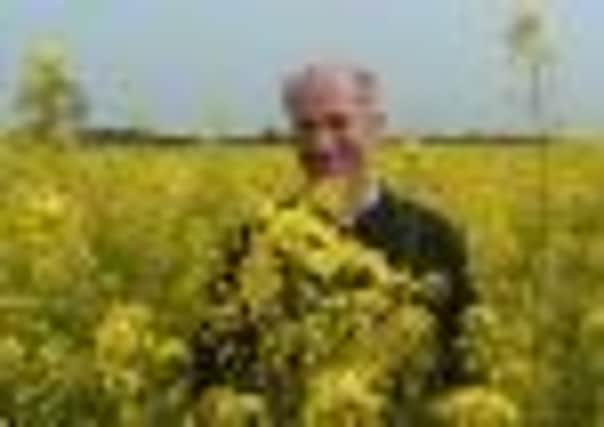Yorkshire’s oilseed gold rush


Centuries ago, its primary use was as a lamp oil and in soap, but in the 1700s, it was discovered that the crop had a useful soil-improving role that aided the performance of following crops.
This is a role that is probably even more vital today and oilseed rape is now known as a break crop – one that helps improve the yield of the following cereal crops, particularly wheat, but it has developed a range of its own uses too.
Advertisement
Hide AdAdvertisement
Hide AdOilseed rape was barely heard of in the UK until the 1970s when a rise in commodity prices and targeted support (funded through the Common Agricultural Policy) raised the price to a sufficiently high level that farmers chose to grow it.
Today’s varieties of oilseed rape provide an oil that is suitable for use in cooking and food processing. Known as vegetable oil, it is used widely by the food industry and is also processed for use as biodiesel.
One common misconception is that the yellow flower is the source of the oilseed. This is not the case at all. The flower has no value, apart from the colour it brings. When the flower dies, a seed pod is formed. Inside the seed pod, which is around four inches long, are a mass of tiny black seeds, each roughly half the size of a peppercorn, that are processed as the crop.
In recent times, a number of family farms have sought to make even greater use of their oilseed rape, producing their own branded products.
Advertisement
Hide AdAdvertisement
Hide AdThe Kilby family, at Lilac Farm, Collingham, near Wetherby, have developed their own version of the crop which they market as rapeseed oil, with a variety of mixes.
They grow 50 acres of oilseed rape producing just over 60 tonnes each year and have their own bottling plant on site. They market their cooking oil under the name Wharfe Valley Farms, and have already won several awards for their products and enterprise.
Sallyann Kilby believes the market for cooking oil from oilseed rape is growing.
‘We started growing rapeseed (or oilseed rape) in the 1980s because we needed something to fit in with our five-year crop rotation. In recent years, we have converted the whole of the home-grown crop into our own finished product pressing the rapeseed oil here at the farm.
Advertisement
Hide AdAdvertisement
Hide Ad“We also have neighbouring farms growing rapeseed to our specification should we need additional volume. Rapeseed has the lowest saturated fat of any culinary oil and less than half that of olive oil, which really does make it a healthier alternative than others.
“We also avoid the use ofchemicals too close to the plant in the way that we harvest the crop. We are slightly different to other farmers in the way that we go about harvest. We swath the crop, which means we cut it with a sharp knife and lay the top of the plant, containing the pod that holds the seeds, on the stalks so that air can get underneath and through it. When we pick up the crop with the combine, it shatters the stalks, the dust then comes out of the back of the combine, leaving the seeds within the combine.”
The Kilbys have also developed a further product from the remnants of their pressed oil.
‘We are now producing briquettes from the husk. We press the oil in one pressing and that leaves a residue. It can be produced as an animal feed but we have also discovered that if you compress it and turn it into a briquette, it comes out very tight and burns better than traditional briquettes.
Advertisement
Hide AdAdvertisement
Hide Ad“We’re getting a lot of interest from people who have open fires or multi-fuel stoves, and our son, Stephen, has recently started another new venture, Wharfe Valley Stoves, as a result of this.’
More than one million acres of oilseed rape are now grown every year in the UK, and the Kilbys are just one farming family making the most from the sea of yellow that adorns our countryside.
Further north, the Sanderson family of Sandholme Farm, Skipton on Swale, has found that it is not just the pod that can make money for the farm from the crop. They are manufacturing products from the oilseed rape straw and have come up with a premium product – horse bedding.
David Sanderson grows 90 acres of oilseed rape on his 300-acre farm and realised that the crop had potential beyond the seeds; indeed, so much so that he is also buying straw from neighbouring farms to keep up with the orders. The family now trade the straw as Bedwell Horse Bedding.
Advertisement
Hide AdAdvertisement
Hide Ad“Horses seem to do a lot better on oilseed rape straw than wheat straw. It has less dust and cleans up well. Two bales of our material equate to three bales of woodshavings. We only started just over a year ago but we are already buying straw from other local farms to fulfil our orders. We have also developed bedding for pheasants and poultry.”
Farmers have been receiving around £250 a tonne for oilseed rape for a number of years, which sounds good in comparison to other crops, but the yield per acre is far less than wheat or barley.
“We used to call oilseed rape our ‘black gold’,” says Sallyann Kirby. “But now that barley and wheat prices are much higher than they were, it’s maybe not quite the ‘black gold’ it once was.”